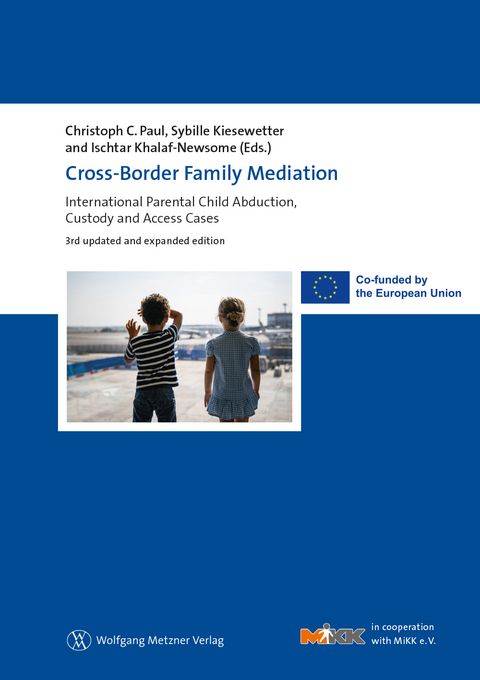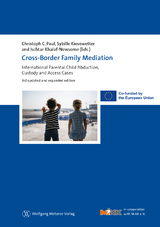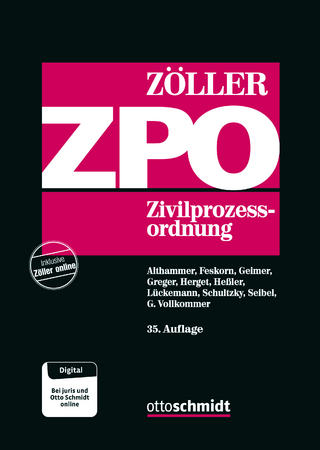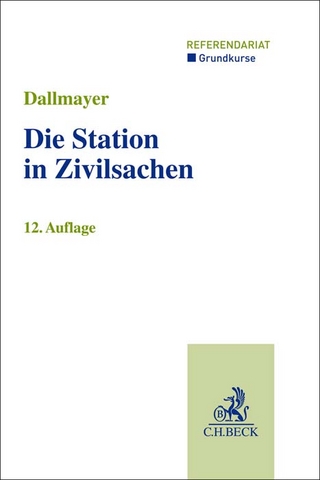Cross-Border Family Mediation
Wolfgang Metzner Verlag
978-3-96117-133-0 (ISBN)
- Überblick über den einschlägigen internationalen Rechtsrahmen für solche Fälle
- Anleitung zu den besonderen Merkmalen grenzüberschreitender Familiensachen sowie den eingesetzten Methoden, Mediationsmodellen und Instrumenten
- Informationen zur Koordinierung der Mediation mit Gerichtsverfahren in Kindesentführungsfällen
- Leitlinien für die grenzüberschreitende Vollstreckbarkeit von im Mediationsverfahren geschlossenen Familienvereinbarungen
- Ansätze und bewährte Praktiken für die Mediation in Fällen mit (muslimischen) Ländern, die nicht dem Haager Übereinkommen angehören
- Informationen zur Einbeziehung der Stimme des Kindes in die Mediation, Online-Mediation, Zweisprachigkeit in der grenzüberschreitenden Mediation
- praktische Informationen und Ressourcen wie z.B. Fallstudien, Muster für Mediationsvereinbarungen und Gerichtsbeschlüsse, eine Vorlage für eine Gerichtsstandsvereinbarung, Checklisten, Links wichtiger Ansprechpartner und Texte der anwendbaren internationalen Rechtsinstrumente
-------
The 3rd updated and expanded edition of this reference book is indispensable reading for experienced family mediators and all other professionals involved in cross-border family conflicts and child abduction cases. A diverse range of contributions from leading international experts in the field make this an invaluable resource covering:
- an overview of the relevant international legal framework for such cases
- insight into the specific characteristics of cross-border family cases, the methodologies, mediation models and tools employed
- information on coordinating mediation with court proceedings in child abduction cases
- guidance on the cross-border enforceability of mediated family agreements
- family law trends and mediation in cases with non-Hague Convention (Muslim) countries
- the voice of the child, mediating online, bilingualism in mediation
- practical information and resources, such as case studies, sample mediation agreements and court orders, a template of a choice of court agreement, checklists, important contacts and applicable legal texts
List of authors: Lin Adrian, Lesley Allport, Charlotte Baek Risbjerg, Sabine Brieger, Eberhard Carl, Mary Carroll, Martina Erb-Klünemann, Juliane Hirsch, Mohamed M. Keshavjee, Ischtar Khalaf-Newsome, Sybille Kiesewetter, Kyra Nehls, Christoph C. Paul, Jamie Walker, Konstanze Welz
Christoph C. Paul ist seit 1978 als Rechtsanwalt und Notar tätig. Seit 1995 ist er Mediator (BAFM). Er arbeitet als Mediator in eigener Praxis in den Bereichen der Familien- sowie Erb- und Wirtschaftsmediation und ist spezialisiert auf Mediationen bei internationalen Kindesentführungen sowie internationalen Umgangs- und Sorgerechtsverfahren. Von 1999 bis 2011 war er Sprecher der Bundes-Arbeitsgemeinschaft für Familienmediation (BAFM) und ist heute Vorsitzender „MiKK e.V. International Mediation Centre for Family Mediation and Child Abduction“. In den letzten zwei Jahren war Christoph C. Paul Mitglied der Expertengruppe Vorbereitung der Gesetzgebungsarbeiten für ein Mediationsgesetz beim Bundesministerium der Justiz. Er hat diverse Beiträge aus dem Bereich der Mediation publiziert, insbesondere zur Stellung des Rechtes im Mediationsverfahren sowie zu Fragen der Internationalen Mediation. Christoph C. Paul wurde wegen seines ehrenamtlichen Engagements um die Implementierung von Mediation bei internationalen Kindschaftskonflikten mit dem Verdienstkreuz am Bande der Bundesrepublik Deutschland ausgezeichnet. 2010 erhielt er als langjähriger praktizierender Mediator und als »Mediator der Mediation« in institutionellen Zusammenhängen den Sokrates- Preis für Mediation.
Sybille Kiesewetter ist Dipl.-Psychologin und Mediatorin. Seit 2006 ist sie freiberuflich als Mediatorin, Trainerin, Supervisorin und Beraterin tätig. Schwerpunkte ihrer Arbeit sind Konzeptentwicklung und Lead Trainerin verschiedener (EU-)Projekte, wie z.B. Trainerin für MiKK e.V., „Training in International Family Mediation“, „LEPCA – Lawyers in Europe on Parental Child Abduction“, Trainerin zusammen mit E. Carl des austr.-jap. Familienmediationsprojektes in Japan und Trainerin für “Emotionalität in der anwaltlichen Praxis”.
Acknowledgements ... 11
Foreword Ewa Kopacz ... 13
Preface Christoph C. Paul, Sybille Kiesewetter & Ischtar Khalaf-Newsome ... 15
Parental Child Abduction – A Personal Story Konstanze Welz ... 23
Section 1 Mediation in Cross-border Family Cases ... 41
Family Mediation in an International Context
Sybille Kiesewetter & Christoph C. Paul ... 43
1. Cross-border Parental Child Abduction and Access Conflicts ... 43
2. Challenges of Mediating Cross-border Disputes Involving Parents and Children ... 43
2.1 Putting Mediation on the Agenda – Public Outreach ... 43
2.2 Suitability for Mediation ... 44
2.3 Particularities of Mediation in 1980 Hague Convention Cases ... 45
2.4 Finding Suitable Mediators ... 46
2.5 Motivating Parents and Lawyers ... 48
2.6 Preparing the Mediation Process ... 49
2.7 Time Needed in the Preparatory Stage ... 50
2.8 Location of the Mediation ... 51
2.9 Timeframe of the Mediation ... 51
2.10 Particular Features Related to the Stages of Mediation ... 52
2.11 Who Else Should be Involved in the Mediation? ... 54
2.12 Collaboration of the Co-mediators ... 55
2.13 How Should the Lawyers of Both Parents be Integrated? ... 55
2.14 How Should the Courts be Integrated? ... 56
2.15 Particularities in Relation to the Mediation Process ... 57
2.16 Language, Communication, Documents, Resources ... 58
2.17 Agreement to Mediate ... 59
2.18 Fees and Expenses ... 59
2.19 Final Agreement – Memorandum of Understanding ... 60
2.20 Post-mediation Care and Support ... 60
3. References ... 61
Mediation in Action
Eberhard Carl & Jamie Walker ... 63
1. Introduction ... 63
2. The Challenges of Mediating Cross-border Family Conflicts ... 63
3. Making the Best of an “Impossible” Situation ... 64
4. Methodology, Dynamics and Attitude ... 66
5. Case Study ... 70
6. Bi-national Projects and Wider International Cooperation ... 72
6.1 Developing Professional Mediation: The German-French Project ... 72
6.2 Dealing With Different Legal Cultures: The German-US Project ... 74
6.3 Cooperation at All Levels: The German-Polish Project ... 76
6.4 Bridge to Asia: The German-Japanese Project ... 78
6.5 International Cooperation and Networking ... 78
7. Conclusion ... 81
8. References ... 81
International Parental Child Abduction to Non-Hague Muslim Countries: Mediation as a Viable Option
Mohamed M. Keshavjee & Ischtar Khalaf-Newsome ... 83
1. Introduction ... 83
2. The 1980 Hague Convention and Muslim Countries ... 84
2.1 The 1980 Hague Child Abduction Convention: Key Provisions ... 84
2.2 Perceived Obstacles to Muslim Countries Joining the 1980 Hague Convention ... 86
2.3 International Initiatives Between Hague Convention Countries and Non-Convention Muslim Countries ... 91
3. Mediation as a Viable Option in Child Abduction Cases to Non-Convention Muslim Countries ... 93
3.1 Working Party on Mediation in the Context of the Malta Process ... 93
3.2 Mediation in Different Cultures and the Development of Cross-border Family Mediation ... 94
3.3 The Amenability to Mediation of Family Conflicts in Islam ... 97
3.4 Cross-border Family Mediation in a Muslim Context: Towards a Model and Standards ... 98
3.5 Cross-border Family Mediation Training for a Muslim Context: A Culturally Appropriate Model ... 103
4. Conclusion ... 105
5. References ... 107
The Voice of the Child in International Family Mediation
Lesley Allport ... 111
1. Introduction ... 111
2. The Legislative Framework ... 111
3. Insights from Research ... 114
4. Involving Children in Mediation ... 116
5. A Practice Model ... 121
6. Considerations Specific to Cross-border Mediation Cases ... 125
7. Conclusion ... 127
8. References ... 128
Cross-border and Bilingual: Bridging the Linguistic Gap
Mary Carroll ... 131
1. Introduction ... 131
2. Parties in Conflict ... 132
3. Complex Problem: Clear-cut Solution? ... 133
3.1 Intercomprehension ... 135
3.2 The Co-mediator as Interpreter ... 135
3.3 From a Triad to a Quadrant – Enlisting an Interpreter ... 137
4. Role Plays and Interviews ... 141
5. Conclusion ... 142
5.1 Suggestions for Mediators of Bilingual Cross-border Mediations ... 143
6. References ... 145
Mediation With a Twist – Handling Mediation Online
Lin Adrian & Charlotte Baek Risbjerg ... 147
1. Introduction ... 147
2. Online Dispute Resolution – Definition and Formats ... 148
3. Specificities in Video-supported Mediation ... 149
4. Suggestions for Video-mediation Practices ... 155
4.1 Handling the Technology. ... 156
4.2 Ensuring a Good Process ... 158
4.3 Working with Interpersonal Relations ... 159
4.4 Handling Communication and Lack of Social Cues ... 161
4.5 Considering Co-mediation ... 162
5. In Closing ... 163
6. References ... 164
Cross-border Family Mediation (CBFM) Training
Jamie Walker & Ischtar Khalaf-Newsome ... 167
1. Introduction ... 167
1.1 The Development of Cross-border Family Mediation (CBFM) Into a Specialist Field ... 168
1.2 Best Practices in Cross-border Family Mediation ... 169
2. The Need for CBFM Training and Training Initiatives ... 171
2.1 Training Needs for CBFM Mediators ... 171
2.2 CBFM Training Needs for Other Target Groups ... 172
2.3 Training Initiatives and Training Models ... 174
3. Training Content and Methodology ... 175
3.1 Content ... 176
3.2 Training Methodology ... 183
3.3 The Need for Qualified Trainers ... 184
4. Networking and On-going Support ... 184
5. Conclusion ... 184
6. References ... 185
Section 2 The Legal Context of Cross-border Family Cases ... 187
The Legal Framework of Child Abduction Cases
Kyra Nehls ... 189
1. Introduction ... 189
2. The Legal Framework of the Hague Convention on the Civil Aspects of International Child Abduction (1980 Hague Convention) ... 189
2.1 Scope ... 190
2.2 Substantive Requirements for Return ... 190
2.3 Ban on a Decision on the Merits of Custody Rights (art. 16) ... 191
2.4 Exceptions to the Obligation to Return the Child Immediately ... 192
2.5 Procedural Steps ... 193
2.6 Special Features of the Brussels IIb (Recast) Regulation ... 194
2.7 De-escalation Measures to End Proceedings ... 195
3. European Convention on Recognition and Enforcement of Decisions Concerning Custody of Children and on Restoration
of Custody of Children (European Custody Convention) ... 198
4. Abductions in Contracting States Not Party to the 1980 Hague Convention ... 199
5. International Rights of Custody and Access ... 199
5.1 Brussels IIb Regulation ... 199
5.2 Hague Convention Concerning the Powers of Authorities and the Law Applicable in Respect of the Protection of Infants
(1961 Hague Convention) ... 201
5.3 Hague Convention of 19 October 1996 on Jurisdiction, Applicable Law, Recognition, Enforcement and Co-operation
in Respect of Parental Responsibility and Measures for the Protection of Children (Hague Child Protection Convention) ... 201
5.4 Access Rights Under the 1980 Hague Convention ... 204
5.5 Rights of Access Under the European Convention on Recognition and Enforcement of Decisions Concerning
Custody of Children and on Restoration of Custody and Children ... 204
5.6 Convention on Contact Concerning Children (Contact Convention) ... 204
5.7 Autonomous Law ... 205
6. Conclusion ... 206
7. References ... 206
Integrating Mediation Into Return and Parental Responsibility Court Proceedings
Eberhard Carl & Martina Erb-Klünemann ... 207
1. Introduction ... 207
2. Court Proceedings for the Return of the Child ... 207
3. Advantages of Integrating Mediation ... 211
4. Integrating Mediation Into Court Proceedings ... 212
5. Return Proceedings Under the 1980 Hague Convention ... 213
5.1 Promotion of Mediation ... 213
5.2 Working Groups ... 214
5.3 German Working Group Recommendations ... 215
5.4 Further Considerations When Recommending Mediation ... 217
6. Financing Mediation ... 222
6.1 Systems of Financing Mediation ... 222
6.2 Statement of Costs ... 224
7. Integrating Results of Mediation Into Court Proceedings ... 226
7.1 Mediation as a Safe Place ... 226
7.2 Content of a Mediated Agreement ... 227
7.3 Rendering an Agreement Legally Binding ... 227
7.4 Choice of Court Agreements Under the Brussels IIb Regulation ... 229
8. Cross-border Parental Responsibility and Contact Proceedings ... 231
9. Conclusion ... 232
10. References ... 232
A Best Practice Model: MiC-Mediators in Court
Sabine Brieger ... 237
1. Introduction ... 237
1.1 International Family Proceedings ... 237
1.2 Specialised Family Mediation ... 238
1.3 Proceedings Under the 1980 Hague Child Abduction Convention and Mediation ... 239
2. The “Mediators-in-Court” (MiC) Model ... 240
2.1 Written Information About Mediation ... 240
2.2 Particularities of the MiC Model ... 240
2.3 The Decisive Difference ... 243
3. Suggestions for Further Promotion of Mediation in Return Proceedings ... 245
3.1 Legal Requirements ... 245
3.2 Specialised Mediation and Mediation Structures ... 246
3.3 Financing ... 246
3.4 Training ... 247
3.5 The Role of Lawyers ... 247
3.6 Standardized Procedure ... 247
3.7 Legal Implementation of an Agreement Reached in Mediation ... 248
4. Conclusion ... 249
5. References ... 249
Rendering Mediated Family Agreements Legally Binding and Enforceable
Juliane Hirsch & Sabine Brieger ... 251
1. Introduction ... 251
2. General Considerations ... 251
2.1 Why Is It Important to Render Mediated Agreements Legally Binding and Enforceable? ... 251
2.2 What Are the Main Challenges in Practice? ... 252
2.3 What Are General Requirements for an Agreement to Become Legally Binding and Enforceable in One Legal System? ... 253
2.4 Identifying the Relevant International Procedural Law and the Ideal “Starting Point Jurisdiction” ... 258
3. International Work Undertaken to Improve the Situation ... 260
4. Sample Agreement and Guidance in Practice ... 262
4.1 Family Agreement in a German-Polish Case ... 262
4.2 How to Render the Agreement Legally Binding and Enforceable in Germany ... 263
4.3 How to Render the Agreement Legally Binding and Enforceable in the Other State – Poland – With the Help of
International/Regional Legal Instruments ... 268
5. Need for Legislative Activity – on the National and International Level ... 268
5.1 On the National Level ... 268
5.2 On the International Level ... 270
6. References ... 272
Section 3 Important Contacts, Guidelines and Resources ... 273
1. Important Contacts ... 275
2. Weblinks to Important Resources ... 276
2.1 Links to Practice Guides & Information Films and Other Resources ... 276
2.2 Links to Important Legal Resources, Declarations & Legal Instruments ... 277
3. Checklists ... 278
3.1 Checklist for Requirements for an Order of Return ... 278
3.2 Procedural Checklist for Judges ... 279
4. Court Information Letters ... 282
4.1 Information for Conflict Parties: An Example From Germany ... 282
4.2 Information for Lawyers: An Example From Germany ... 284
5. Stages of Mediation ... 287
6. Agreement to Mediate ... 288
7. Examples of Mediated Parental Agreements ... 291
7.1 Parental Settlement and Court Order – Germany ... 291
7.2 Parental Settlement and Mirror Order – USA ... 293
8. Choice of Court Agreement ... 298
9. Wroclaw Declaration ... 301
Section 4 Legal Instruments ... 303
1. 1980 Hague Convention ... 305
2. Brussels IIb (Recast) Regulation ... 318
3. 1996 Hague Child Protection Convention ... 398
4. Mediation Directive 2008/52/EC – European Parliament and of the Council ... 418
Section 5 Case Studies ... 429
A Bangladeshi-British Mediation
Mohamed M. Keshavjee ... 431
The Role of Consulting Lawyers
Christoph C. Paul & Jamie Walker ... 437
From Child Abduction to Property Distribution
Christoph C. Paul & Jamie Walker ... 445
Notes on Contributors ... 455
List of Authors ... 467
Index 471
| Erscheinungsdatum | 20.10.2023 |
|---|---|
| Sprache | englisch |
| Maße | 148 x 210 mm |
| Gewicht | 684 g |
| Einbandart | Paperback |
| Themenwelt | Recht / Steuern ► Privatrecht / Bürgerliches Recht ► Zivilverfahrensrecht |
| Schlagworte | 1980 Hague Convention • 1996 Hague Convention • agreement to mediate • Bilingual Family Mediation • Child abduction • Cross-Border Family Dispute Resolution • Cross-Border Family Mediation • Cross-Border Family Mediation Training • Enforceability of Cross-border Family Agreements • EU Mediation Directive • Familienmediation • grenzüberschreitene Mediation • interkulturelle Mediation • International Child Abduction Law • International mediation • International Parental Child Abduction • Legal Framework in Child Abduction Cases • Mediation and Court Proceedings • Mediation in Non-Hague Muslim Countries • Mediationmediation laws • Mediation mit Mehrsprachigkeit • Mediation Tools and Methodologies • MiKK International Mediation Centre for Family Conflict and Child Abduction • Muslim family law • Online Mediation • parental agreements • parental responsibility • sorgerechtsverfahren • The Brussels IIb Recast Regulation • The Voice of the Child |
| ISBN-10 | 3-96117-133-5 / 3961171335 |
| ISBN-13 | 978-3-96117-133-0 / 9783961171330 |
| Zustand | Neuware |
| Informationen gemäß Produktsicherheitsverordnung (GPSR) | |
| Haben Sie eine Frage zum Produkt? |
aus dem Bereich




